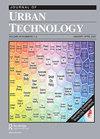3D数字参与式规划能否提高智慧城市的社会可持续性?经济欠发达地区的实证评价研究
IF 4.6
3区 经济学
Q1 URBAN STUDIES
引用次数: 16
摘要
本研究评估了三维数字参与式规划(3DDPP)对规划实践的影响。这种方法在荷兰Schiedam市一个弱势社区的重建项目框架内进行了测试。一群共同设计社区公共空间的居民使用了一个交互式的3DDPP工具。居民有机会以3D格式在线可视化项目区域,提出他们的想法,对设计方案进行评论,在线制作交互式图形设计,并相互互动。这一过程的影响是根据五项标准(效率、可行性、吸引力、互动性和满意度)进行测试的,这些标准是通过与九名专家合作的自由清单和堆分类方法制定的。采用定性驱动(qualal)混合方法对62名包括专业人员和公民在内的受试者样本进行数据分析。结果表明,使用3DDPP工具可以潜在地提高社区参与决策。本文最后强调,社会经济、政治和人口方面的挑战可能会降低居民积极参与协作决策的意愿,这些挑战可能不仅仅通过技术来解决。本文章由计算机程序翻译,如有差异,请以英文原文为准。
Would 3D Digital Participatory Planning Improve Social Sustainability in Smart Cities? An Empirical Evaluation Study in Less-Advantaged Areas
ABSTRACT This study evaluates the impact of using three-dimensional digital participatory planning (3DDPP) on planning practices. This method was tested within the framework of a redevelopment project in one of the less-advantaged neighborhoods in the Dutch city of Schiedam. An interactive 3DDPP tool was employed by a group of residents who co-designed public spaces in the neighborhood. Residents were given the opportunity to visualize online the project area in 3D format, suggest their ideas, comment on the design proposal, produce interactive graphical designs online, and interact with each other. The impact of this process was tested according to five criteria (efficiency, feasibility, attractiveness, interaction, and satisfaction) developed via free-listing and pile-sorting methods in collaboration with nine experts. A qualitatively driven (QUAL) mixed method was used to analyze the data collected from a sample of 62 subjects, which included professionals and citizens. The results showed that the use of 3DDPP tools can potentially enhance community engagement in decision-making. This article concludes by emphasizing that socioeconomic, political, and demographic challenges, which might decrease the residents’ willingness to be actively engaged in collaborative decision-making, might not solely be solved via technologies.
求助全文
通过发布文献求助,成功后即可免费获取论文全文。
去求助
来源期刊

Journal of Urban Technology
URBAN STUDIES-
CiteScore
8.50
自引率
4.20%
发文量
42
期刊介绍:
The Journal of Urban Technology publishes articles that review and analyze developments in urban technologies as well as articles that study the history and the political, economic, environmental, social, esthetic, and ethical effects of those technologies. The goal of the journal is, through education and discussion, to maximize the positive and minimize the adverse effects of technology on cities. The journal"s mission is to open a conversation between specialists and non-specialists (or among practitioners of different specialities) and is designed for both scholars and a general audience whose businesses, occupations, professions, or studies require that they become aware of the effects of new technologies on urban environments.
 求助内容:
求助内容: 应助结果提醒方式:
应助结果提醒方式:


